For many generations, people have been taking advantage of transportation. Back when automobiles were symbolized as bullock carts, pipelines, and bicycles, today have changed to motorbikes and cars, airplanes, trains, etc.
We have evolved with time and welcomed the new lanes of convenience through everything we do today, starting from the way we live and eat to the way we fashion, communicate, and transit.
If we look at the current transportation scenarios, it is major inclined to today’s digital transformation needs and is overwhelmed with the increased demand of the app development industry. This is why many companies like Uber, Ola, Lyft, Bolt, and others took the step to build a taxi service app that beholds the heart of 300+ million users across the world.
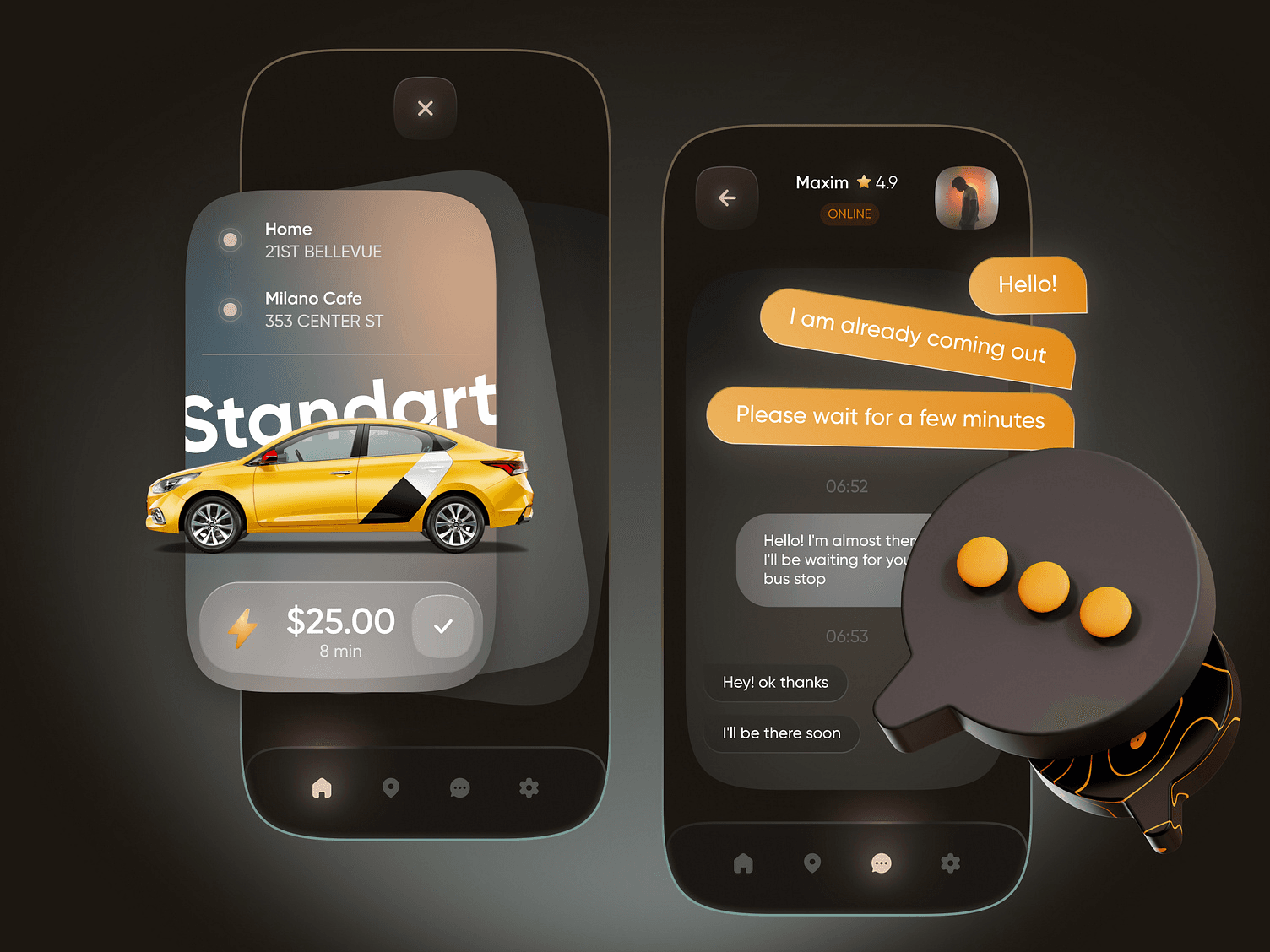
After reading all this, aren’t you a bit curious to find out what it is like to be when you create your own successful Taxi app services for your country?
Ridesharing and Taxi app development services are pretty much out there with a total of 1000+ apps available on the Google Play Store and Apple App Store. So, if you are a localite looking to expand your transportation business to online services, consider this blog yours!
Statistical Insights On The Use Of Taxi Applications
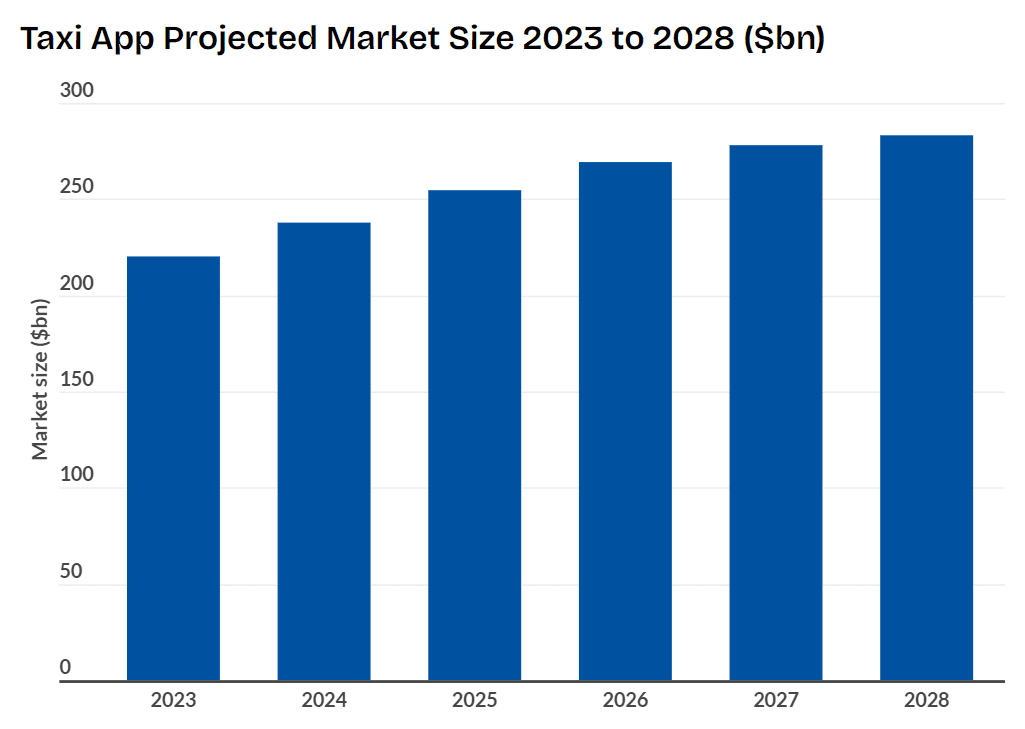
- The taxi app market size is expected to grow by $283 billion in 2028 at a 4.2% CAGR between 2023 to 2028.
- From the 2022 report, the top taxi app company DiDi collected a total of $19.7 billion, followed by Uber which came second and collected $14 billion.
- Over 300 million people use taxi apps in the world, with DiDi and Uber responsible for about 150 million of those users. The industry had a major dip in 2020, losing over 100 million active users due to the coronavirus pandemic.
- Uber had a commanding lead in the US market until 2018, when harassment charges against the then-CEO Travis Kalanick, alongside general driver unhappiness, led to a boycott as some users shifted to Lyft. It has regained footing, with a 76% market share in 2022.
- Obtaining clients may not be as user penetration since the user penetration rate is around 21.9%, and the overall number of ride-hailing customers is projected to amount to 1.92 billion users by 2027.
What Values Does Taxi App Development Adds To Transport Business?
The value of taxi app services is top-notch. Here are a few reasons why businesses should invest in this industry:
1. Enhanced Customer Convenience
Taxi app development significantly enhances customer convenience by simplifying the ride-booking process. Customers can book a ride with just a few taps on their smartphones, anytime and anywhere. This ease of access eliminates the need to hail taxis on the street or make phone calls to dispatch centers.
Additionally, the ability to track the ride in real-time provides customers with accurate information about the driver’s location and the estimated time of arrival, reducing uncertainty and wait times. Multiple payment options integrated into the app offer flexibility, allowing customers to choose from credit/debit cards, mobile wallets, or cash.
The app also maintains a ride history, enabling customers to review their past trips and expenses, which can be particularly useful for budgeting and expense reporting.
2. Improved Operational Efficiency
Taxi apps automate the dispatching process, matching drivers with passengers efficiently and reducing the time passengers spend waiting for their rides. This automated system optimizes route planning and reduces operational bottlenecks.
With better allocation and management of vehicles and drivers, the app ensures that resources are used effectively, minimizing idle time and maximizing service availability.
Data analytics play a crucial role in operational efficiency by providing insights into customer behavior, peak travel times, and operational bottlenecks. These insights help in making informed decisions, improving service quality, and optimizing operational strategies.
3. Increased Safety and Security
Safety and security are paramount in the taxi apps and travel and transport app development solutions addresses these concerns effectively. Comprehensive driver verification processes, including background checks and identity verification, ensure that only qualified and reliable drivers are allowed on the platform.
Real-time trip monitoring allows the company to track every ride, ensuring passenger safety and quick response in case of emergencies. In-app emergency buttons provide an additional layer of security, allowing passengers to alert authorities or emergency contacts if they feel unsafe.
The rating system also contributes to safety by enabling passengers to rate drivers, promoting accountability and high service standards.
4. Cost Savings
Automation through taxi apps leads to significant cost savings for transport businesses. By reducing the need for manual dispatch and administrative work, operational overheads are minimized.
Optimized routing, facilitated by the app, results in better fuel efficiency and reduces vehicle wear and tear. This not only lowers fuel costs but also extends the lifespan of the vehicles, reducing maintenance expenses.
Overall, these cost-saving measures contribute to higher profitability and more efficient operations.
5. Better Customer Retention and Acquisition
Taxi apps help transport businesses attract and retain customers through various features. Loyalty programs and discounts integrated into the app incentivize repeat usage and build customer loyalty.
Personalized experiences, based on user preferences and ride history, enhance customer satisfaction by offering tailored services and promotions. These personalized touches make customers feel valued and increase the likelihood of them choosing the service again in the future.
6. Expanded Market Reach
The scalability of taxi apps allows transport businesses to expand their services to new regions and markets with minimal additional costs.
The digital nature of the app means that it can be easily adapted to different geographical areas, catering to local needs and preferences.
Additionally, digital marketing strategies implemented through the app can target specific customer segments effectively, increasing market reach and customer base.
7. Competitive Advantage
Adopting a taxi app gives transport businesses a competitive edge in the market. Modernization through technology keeps the business competitive with other tech-savvy transport services, attracting a broader customer base that prefers digital solutions.
An intuitive and user-friendly app enhances the brand’s image, portraying it as innovative and reliable. This modern approach not only attracts new customers but also retains existing ones by providing a superior service experience.
8. Environmental Benefits
Taxi apps can promote environmental sustainability by encouraging ride-sharing and carpooling options. By reducing the number of vehicles on the road, these features help lower carbon emissions and traffic congestion. Environmentally conscious customers are more likely to choose services that offer eco-friendly options, contributing to a positive brand image and customer loyalty.
9. Regulatory Compliance
Transport regulations can be complex and challenging to comply with, but taxi apps simplify this process. Features such as automated fare calculations, electronic receipts, and comprehensive ride records help ensure adherence to local regulations.
This reduces the risk of legal issues and penalties, making it easier for the business to operate within the legal framework.
10. Feedback and Improvement
Direct feedback from customers and drivers, facilitated through the app, allows for continuous service improvement. Passengers can provide reviews and ratings for their rides, and drivers can share their experiences and suggestions.
This feedback loop helps identify areas for improvement, enabling the business to make data-driven decisions to enhance service quality. Continuous improvement based on real user feedback ensures that the business stays responsive to customer needs and market trends.
List of Popular Apps Build For Online Taxi Services
Here are five popular apps built for online taxi services:
1. Uber
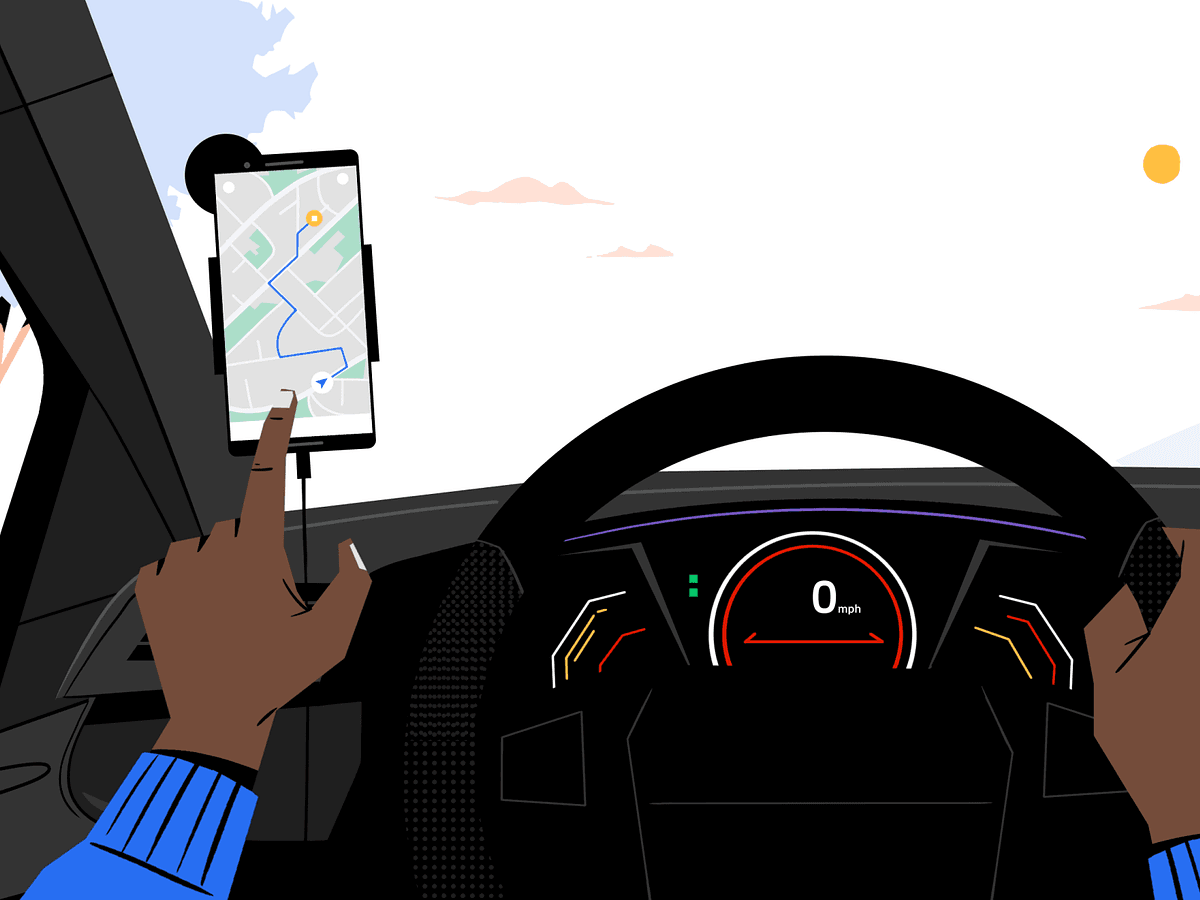
Uber is one of the most well-known and widely used ride-hailing apps globally. It allows users to book rides, track their drivers in real-time, and choose from a variety of vehicle options. Uber’s extensive features include multiple payment options, fare estimation, ride-sharing, and even luxury car services with Uber Black.
Want to build an app like Uber: Here’s a step-by-step guide you must give it a read!
2. Lyft

Lyft is another major player in the ride-hailing market, primarily operating in North America. It offers similar features to Uber, including ride booking, real-time tracking, and various vehicle choices. Lyft also emphasizes community and safety, with features like in-app tipping and a focus on driver-partner benefits.
3. Didi Chuxing
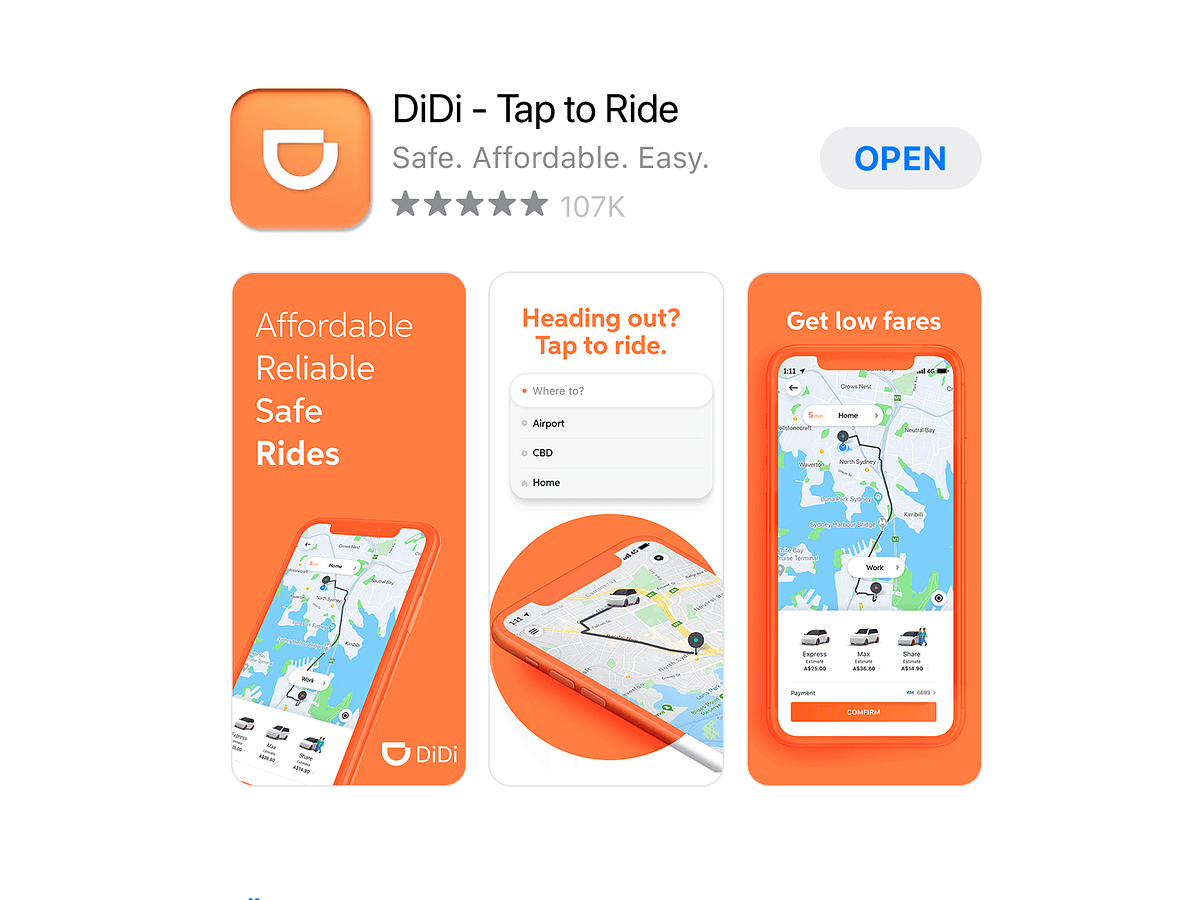
Didi Chuxing is the leading ride-hailing app in China and has expanded its services to other countries. It offers a comprehensive range of transport options, including taxis, private cars, carpooling, and even bike-sharing. Didi is known for its advanced technology and large user base, making it a dominant force in the Asian market.
4. Ola
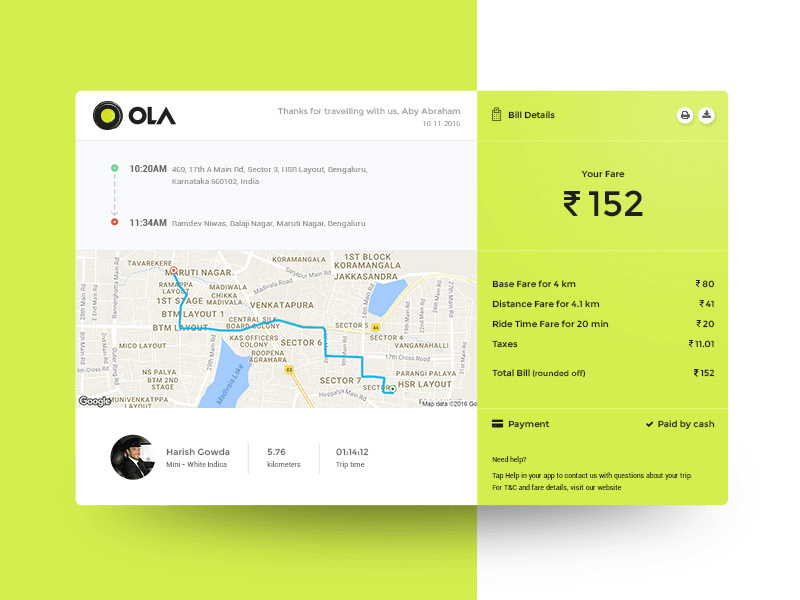
Ola is a popular ride-hailing service based in India, offering a wide range of transportation options from economic to luxury rides. The app features real-time tracking, multiple payment options, and ride-sharing app services. Ola has also expanded its operations to several international markets, including Australia, New Zealand, and the UK.
5. Grab
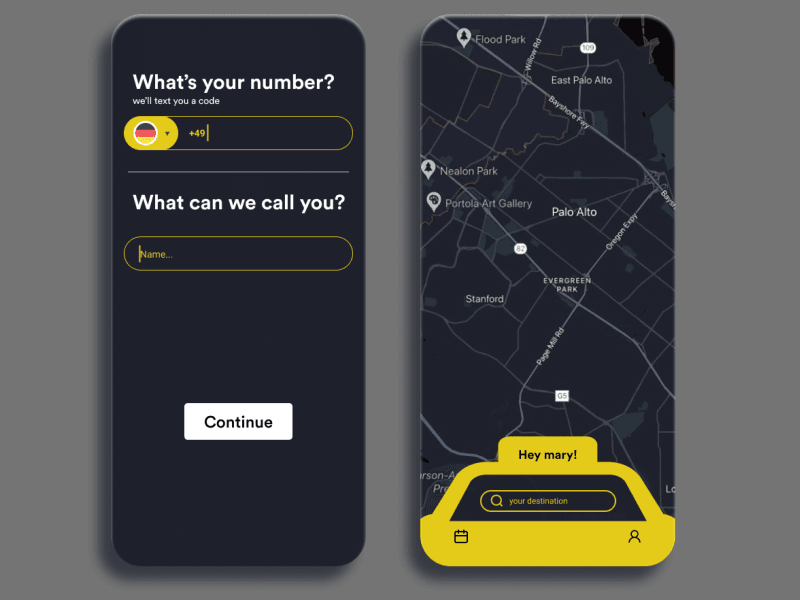
Grab is a leading ride-hailing platform in Southeast Asia, providing not only taxi services but also food delivery, parcel delivery, and digital payment solutions. The app offers diverse transport options, including car, bike, and even e-scooter rides. Grab’s comprehensive ecosystem and focus on regional needs make it a favorite in countries like Singapore, Malaysia, Indonesia, and the Philippines.
What is the Average Cost of a Taxi App Development Service?
The average cost of developing a taxi app can vary widely based on several factors, including the complexity of the app, the features included the geographic location of the development team, and the platform (iOS, Android, or both).
Here are some estimated costs and factors that can influence the overall expense:
Estimated Costs
- Basic Taxi App: A basic app with essential features such as user registration, ride booking, fare calculation, real-time tracking, and payment integration can cost between $20,000 to $40,000.
- Moderately Complex Taxi App: An app with additional features such as multiple payment gateways, advanced analytics, driver and passenger ratings, ride history, and push notifications can range from $40,000 to $80,000.
- Advanced Taxi App: A highly complex app with features like AI-based route optimization, multilingual support, in-app chat, SOS buttons, loyalty programs, and an admin panel for comprehensive management can cost between $80,000 to $150,000 or more.
Cost Breakdown by Feature
- User and Driver Registration: $2,000 – $5,000
- Real-time Tracking and Navigation: $10,000 – $20,000
- Payment Integration: $5,000 – $10,000
- Ride Scheduling and Dispatch: $10,000 – $15,000
- Fare Calculation and Invoicing: $3,000 – $7,000
- Ratings and Reviews: $2,000 – $5,000
- Push Notifications: $1,500 – $3,000
- Admin Panel: $10,000 – $20,000
Factors Influencing Costs
1. Development Team Location:
The cost of hiring developers varies significantly by region. For example, developers in North America and Europe typically charge higher rates ($100 – $200 per hour) compared to developers in Asia or Eastern Europe ($30 – $80 per hour).
2. App Platform:
Developing the app for a single platform (iOS or Android) is cheaper than developing for both. Cross-platform development tools like React Native or Flutter can reduce costs by allowing a single codebase for both platforms.
3. Design Complexity:
A straightforward design will cost less compared to a highly customized and visually complex design.
4. Third-Party Integrations:
The use of third-party services (such as payment gateways, map services, and notification systems) can add to the cost, depending on their licensing and integration complexity.
5. Maintenance and Updates:
Post-launch maintenance, updates, and support also contribute to the total cost over time. This is typically around 15-20% of the initial development cost per year.
Assumed Cost Scenarios
- Basic App by a Small Team in Asia: $20,000 – $30,000
- Moderately Complex App by a Mid-sized Team in Eastern Europe: $50,000 – $70,000
- Advanced App by a Large Team in North America: $100,000 – $150,000+
These estimates provide a general idea, but the actual cost can vary based on specific requirements and market conditions. It’s important to get detailed quotes and project plans from development teams to get an accurate estimate tailored to your project.
What Are The Steps To Create a Taxi App Service For Users?
1. Market Research and Planning
The first step in creating a taxi app service is conducting thorough market research and planning. This involves identifying the target audience and understanding their needs and preferences.
By analyzing the existing market, you can gather insights into what potential users are looking for in a taxi service. Additionally, studying competitors allows you to identify their strengths and weaknesses, helping you to find opportunities for differentiation.
Based on this research, define your unique selling proposition (USP) that sets your app apart from the competition. This initial planning stage is crucial as it lays the foundation for the entire project and guides the development process.
2. Define Features and Functionality
Once the planning phase is complete, the next step is to define the features and functionality of the app. For passengers, essential features include user registration, ride booking and scheduling, real-time ride tracking, fare calculation, payment integration, ride history, and ratings and reviews for drivers.
For drivers, key features should encompass driver registration and verification, ride request management, GPS navigation, earnings tracking, and passenger ratings. Additionally, an admin panel is necessary to manage users, trips, and payments, as well as to generate analytics and reports.
Defining these features clearly helps in creating a detailed project roadmap and ensures that the app meets the needs of all stakeholders.
3. Choose the Technology Stack
Choosing the right technology stack is critical for the development of a taxi app. For front-end development, decide whether to build the app for iOS, Android, or both. iOS development typically uses Swift, while Android development uses Kotlin.
Alternatively, cross-platform development frameworks like React Native or Flutter can be used to build apps for both platforms from a single codebase.
For back-end development, select a robust technology stack that includes a server-side language like Node.js, Django, or Ruby on Rails, a database such as MySQL, PostgreSQL, or MongoDB, and appropriate APIs like RESTful or GraphQL.
Also read: MQL Vs SQL for lead qualification checklist
The technology stack should be chosen based on scalability, performance, and the specific requirements of the app.
4. Design the User Interface
The design phase involves creating an intuitive and visually appealing user interface (UI). Start with wireframing to outline the app’s layout and navigation.
Wireframes help in visualizing the structure and flow of the app without getting bogged down by design details. Once the wireframes are approved, move on to the UI/UX design services, focusing on usability and aesthetics.
Tools like Sketch, Figma, or Adobe XD can be used to design the interface. The design should be user-friendly and provide a seamless experience, ensuring that users can easily navigate and perform tasks within the app.
5. Development
With the design finalized, the development phase begins. This involves both front-end and back-end development. Front-end development focuses on building the user-facing part of the app, ensuring that the UI is responsive and interactive.
Back-end development involves creating the server-side logic, setting up the database, and developing the APIs that will connect the front-end with the back end. Throughout this phase, it is important to integrate third-party services such as payment gateways, map services, and notification systems.
Regular communication between the front-end and back-end teams is crucial to ensure seamless integration and functionality.
6. Testing
Testing is a critical phase in the development process to ensure that the app is functional, reliable, and free of bugs. Start with unit testing to verify that individual components work correctly. Integration testing follows, ensuring that different components interact smoothly.
Conduct user acceptance testing (UAT) with a small group of end-users to gather feedback on the app’s usability and performance.
Additionally, perform performance testing to evaluate how the app handles various conditions and loads. Address any issues identified during testing to ensure a high-quality final product.
7. Launch Preparation
Before launching the app, it’s important to prepare thoroughly. Start with a beta release to a limited audience to gather real-world feedback and identify any remaining issues.
This stage is also the time to plan and execute marketing strategies to create buzz and attract users. Optimize the app’s listing on the Google Play Store and Apple App Store for better visibility through app store optimization (ASO).
This includes using relevant keywords, compelling descriptions, and attractive screenshots to entice potential users.
8. Launch
Once the app is thoroughly tested and optimized, it is ready for launch. Deploy the app to the respective app stores and monitor its performance closely. Provide customer support to address any issues that users may encounter.
Monitoring the app post-launch helps in quickly identifying and fixing any bugs or performance issues that may arise. This stage is crucial for ensuring a smooth user experience and maintaining a positive reputation.
9. Post-launch Activities
After the app is launched, gather feedback from users to identify areas for improvement. This feedback is invaluable for making necessary updates and enhancements.
Regularly update the app with new features, improvements, and bug fixes to keep it relevant and competitive. Continue marketing efforts to attract new users and retain existing ones. Engaging with users and responding to their feedback helps in building a loyal user base.
10. Maintenance
Regular maintenance is essential to ensure the app runs smoothly over time. This includes performing routine checks, updating security measures, and fixing any bugs that arise. Keeping the app secure is particularly important to protect user data and maintain trust.
Additionally, plan for scalability to accommodate a growing user base. Regular maintenance and updates ensure that the app remains functional, secure, and competitive in the market.
By following these steps, you can create a comprehensive and user-friendly taxi app service that meets the needs of both passengers and drivers while maintaining a competitive edge in the market.
Features To Add To A Taxi App Development Services
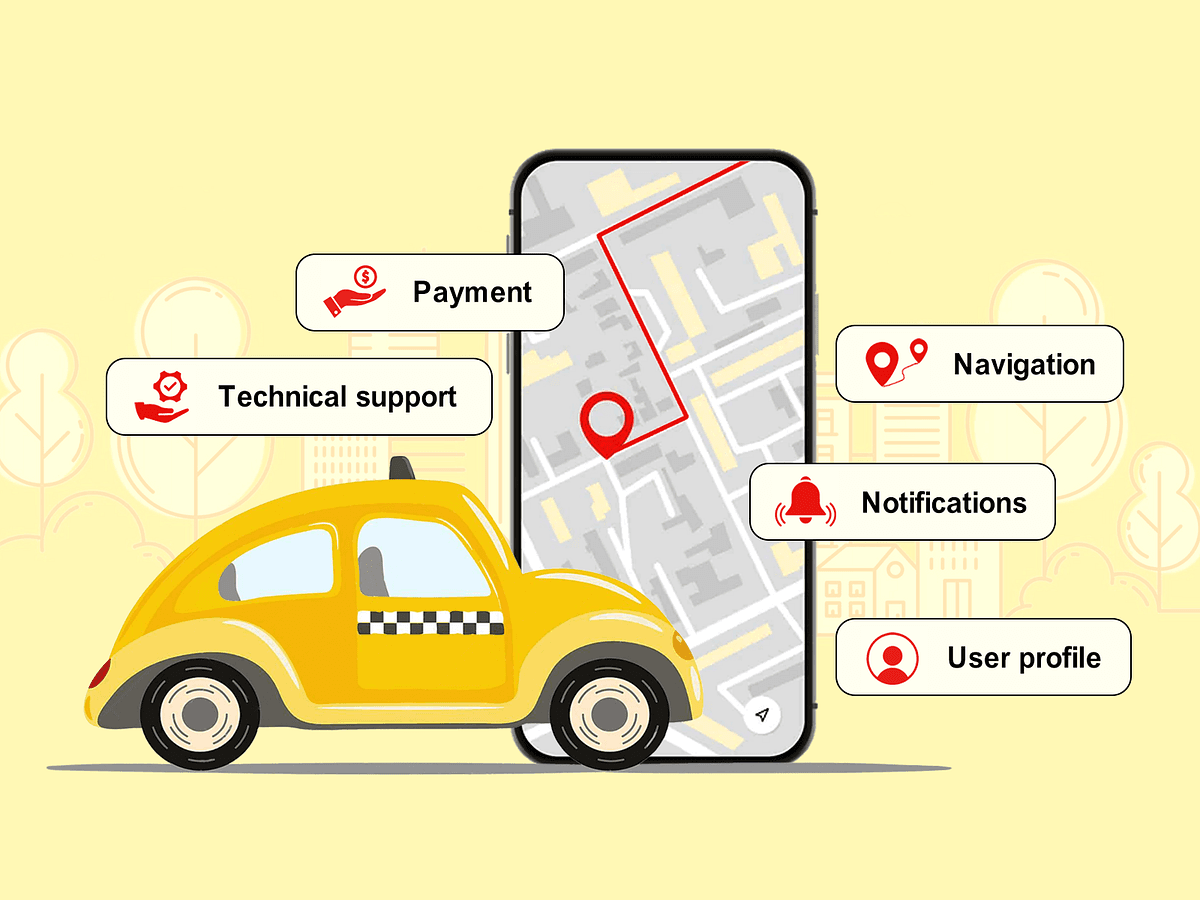
Creating a taxi app involves incorporating features that cater to three main categories: users (passengers), drivers, and administrators (admins). Each category requires specific features to ensure a seamless and efficient experience for everyone involved.
Features for Users (Passengers)
1. User Registration and Profile Management:
Users should be able to create accounts using their email, phone number, or social media profiles. Profile management allows them to update personal details, payment information, and ride preferences.
2. Ride Booking and Scheduling:
The core feature enables users to book immediate rides or schedule future rides. This should include the ability to set pick-up and drop-off locations.
3. Real-time Tracking and Navigation:
Users should be able to track their ride in real-time, seeing the driver’s location and estimated time of arrival. This enhances transparency and security.
4. Fare Calculation and Estimation:
Before confirming the ride, users should see an estimated fare based on distance, time, and traffic conditions. This helps in setting clear expectations.
5. Payment Integration:
Multiple payment options, including credit/debit cards, mobile wallets, and cash, should be available for user convenience. Secure payment processing is crucial.
6. Ride History and Receipts:
Users should have access to their ride history, including detailed receipts. This is useful for record-keeping and expense management.
7. Ratings and Reviews:
After each ride, users should be able to rate their driver and provide feedback. This ensures service quality and accountability.
8. Push Notifications:
Timely notifications about ride status, driver arrival, and promotions keep users informed and engaged.
9. In-app Chat and Support:
Users should be able to communicate with the driver or customer support within the app for any queries or issues.
Features for Drivers
1. Driver Registration and Verification:
A thorough registration and verification process, including background checks and document submissions, ensures that only qualified drivers join the platform.
2. Ride Requests and Management:
Drivers should receive ride requests in real-time, with the option to accept or decline. This feature should also include details about the passenger and pick-up location.
3. GPS Navigation and Route Optimization:
Integrated GPS and navigation systems help drivers find the best routes, reducing travel time and fuel consumption.
4. Earnings Tracking and Reports:
Drivers should have access to their earnings, including detailed reports of their daily, weekly, and monthly income. This helps in financial planning and transparency.
5. Ratings and Reviews:
Drivers can also rate passengers, ensuring mutual respect and safety. Feedback helps maintain a high standard of service.
6. In-app Chat and Support:
Communication tools for drivers to contact passengers or customer support for assistance during trips.
7. Availability Toggle:
A feature allowing drivers to indicate their availability status, helping manage their work hours and breaks.
Features for Admins
1. User and Driver Management:
Admins need tools to manage user and driver accounts, including registration approvals, suspensions, and deletions. This ensures control over who uses the platform.
2. Trip and Fare Management:
Comprehensive management of trips and fares, including setting fare rates, handling disputes, and processing refunds. This feature ensures smooth financial operations.
3. Analytics and Reporting:
Detailed analytics and reporting tools provide insights into various aspects of the business, such as user behavior, driver performance, revenue, and peak usage times. This data is crucial for strategic planning and decision-making.
4. Customer Support Tools:
Admins should have access to tools that help them manage and resolve customer support tickets, ensuring timely and effective responses to issues.
5. Marketing and Promotions Management:
Features to create and manage promotional campaigns, discounts, and loyalty programs to attract and retain users.
6. Real-time Monitoring:
Tools to monitor ongoing trips, ensuring safety and efficiency. This includes the ability to intervene in emergencies or disputes.
7. Compliance and Security Management:
Ensuring that the app complies with local regulations and industry standards. Security features like data encryption and regular audits help protect user information.
8. Push Notifications Management:
Admins should be able to send notifications to users and drivers about updates, promotions, or important information.
Hire DianApps Dedicated Mobile App Developers To Build Your Taxi App
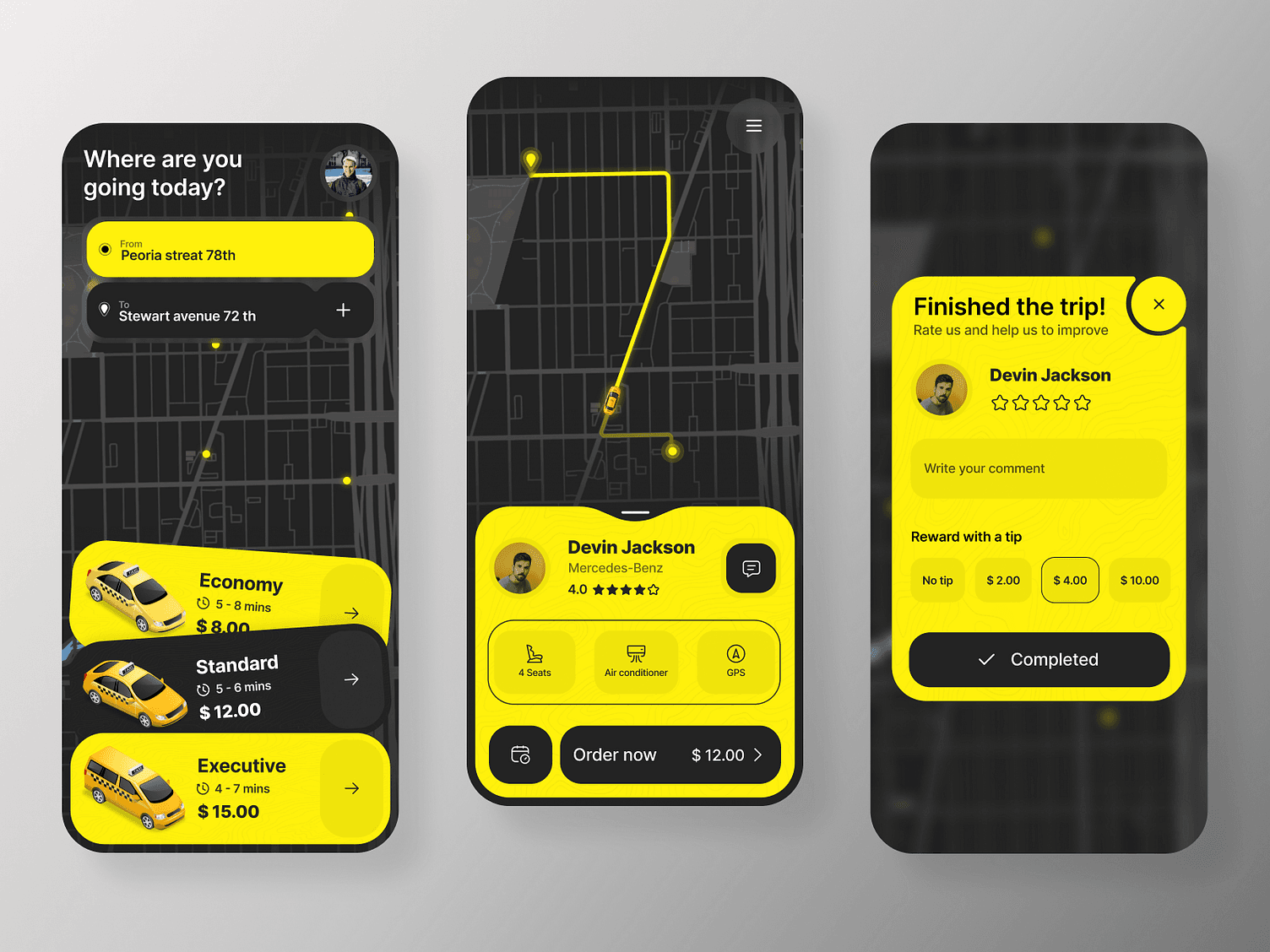
Looking to build a top-notch taxi app that stands out in the competitive market? Hire dedicated mobile app developers from DianApps to turn your vision into reality. Our team of experienced developers specializes in creating fully functional MVP apps and complex apps with feature-rich, user-friendly taxi applications that cater to the needs of passengers, drivers, and administrators.
With our expertise in cutting-edge technology and user-centric design, we ensure your app offers seamless booking, real-time tracking, secure payment options, and comprehensive management tools.
From initial planning and design to development, testing, and deployment, DianApps provides end-to-end solutions tailored to your specific requirements.
At DianApps, we understand the importance of reliability and performance in taxi app services. Our developers are proficient in using the latest frameworks and tools to build robust and scalable applications.
We focus on delivering a smooth user experience with intuitive navigation and essential features that enhance convenience and safety for all users. Whether you need a basic ride-hailing app or an advanced platform with custom features, our team is equipped to handle projects of any complexity.
By partnering with DianApps, you can be confident that your taxi app will not only meet but exceed market expectations.
Ready to bring your taxi app idea to life? Contact DianApps today to hire our dedicated mobile app developers and start your project. Let us help you create a powerful and innovative taxi service that drives success in the digital age.
Get in touch now to discuss your requirements and take the first step towards transforming your transport business.


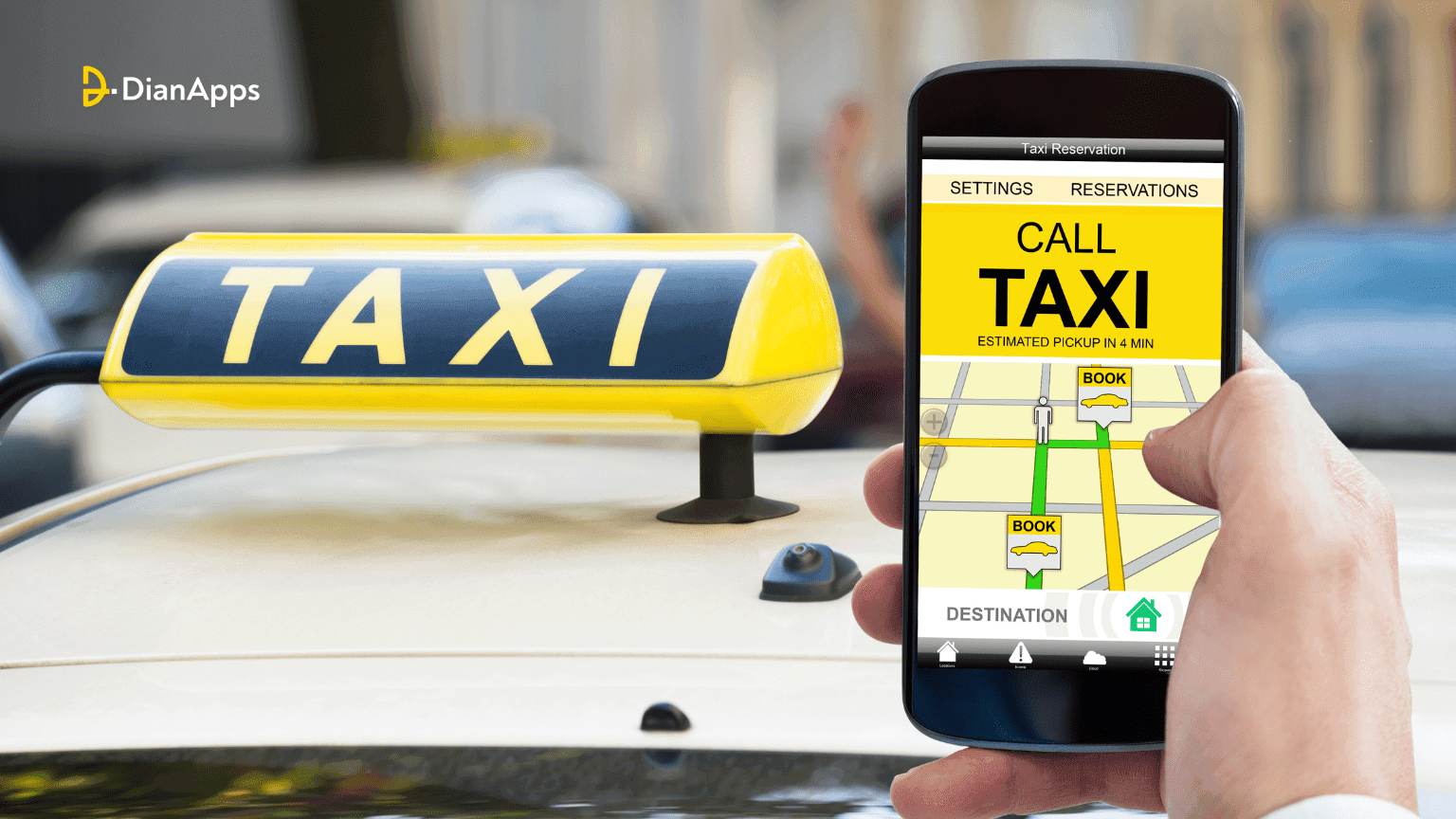
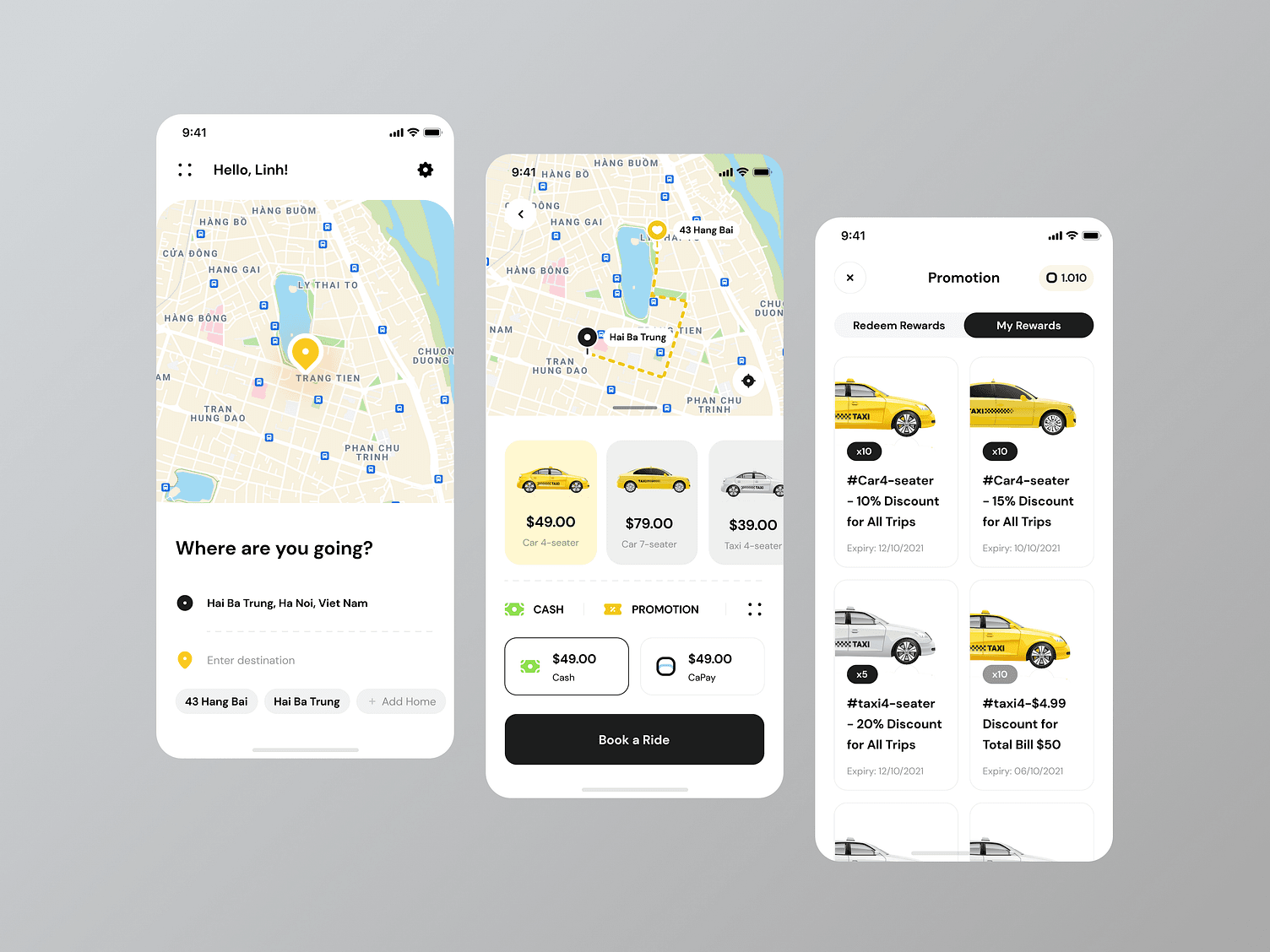







Leave a Comment
Your email address will not be published. Required fields are marked *